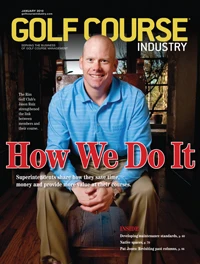"The economy had forced the course to cut back on my labor. Two years ago we had 30 guys on staff and this last year we had, at the most, 18. So wefd cut back quite a bit.
"So the green committee wanted to see how they could help. I told them about a program I had taken part in at another course I had worked at that got the members involved in filling ballmarks and divots. I presented the idea to the committee and they liked it.
"So I made up an invitation in Microsoft Word that explained the event and what we could accomplish and I sent that as a mass e-mail to all of the members.
"We had 21 people attend, and I was expecting only five or six people, mostly green committee membersc maybe.
"And of those people who came out, many were the spouses of the guys who golf all of the time. So it was a nice, surprising turnout.
"I paired people up in golf carts and everybody had a bottle of sand/seed mix. I had another guy with me and basically I took one set of nine holes and he had the other nine and we rotated around the different groups refilling the bottles with seed/sand mix. We had one group on the fairway fixing divots and one group on the green fixing all the ballmarks. And when they got done they would leapfrog to the next fairway. As quickly as we could go around we were filling their bottles up. Ifd say to finish everything it only took us about an hour and 15 minutes.
"After that we spent a couple of hours at a happy hour event. There I held a question-and-answer session where I addressed everyonefs questions about the course, the conditions and how we maintain it. People had questions about the havalina (a type of wild pig) and the elk that come in every year and, of course, people had questions about our bunkers.
"Altogether, the whole program had a very minimal cost. Since it was just me and another guy, and wefre both salaried employees, we essentially didnft have any cost. The sand/seed cost, maybe, $150. At the happy hour the members paid for themselves, so we didnft have to supply anything. With our budget they understood why they had to pay for it, and really, theyfd end up paying for it anyways.
"I was surprised by the level of involvement and the questions they had, especially on what was the best way to fill a ballmark and what the best way was to replace a divot, which is tough in the desert heat. They really asked a lot of good questions. Because of our initial success, in the future wefd like to schedule this program to take place at least once a month and make it a regular occurrence.
"In the end, we really got a lot more out of this program than just getting the divots and ballmarks fixed. It really gave our membership a greater appreciation for the work that goes into maintaining a golf course, and it was refreshing to realize they were interested in the work we were doing and they cared about doing things right when they play."
@
@
@

Explore the January 2010 Issue
Check out more from this issue and find your next story to read.
Latest from Golf Course Industry
- From the publisher’s pen: Conscientious of a bigger role
- Bernhard and Company partners with Laguna Golf Phuket
- Terre Blanche showcases environmental stewardship
- VIDEO: Introducing our December issue
- Bernhard and Company introduces Soil Scout
- Nu-Pipe donates to GCSAA Foundation’s Centennial Campaign
- GCSAA enhances golf course BMP tool
- Melrose leadership programs sending 18 to 2026 GCSAA Conference and Trade Show





